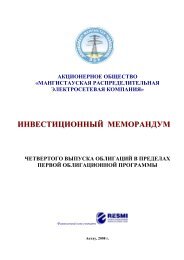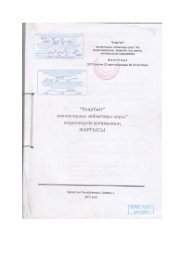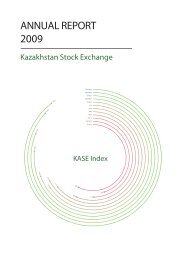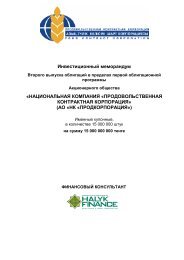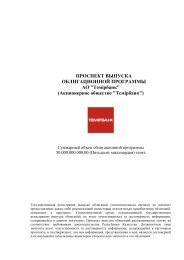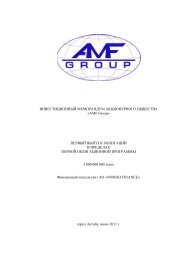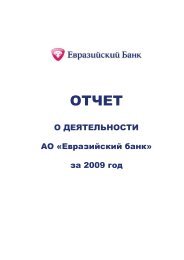JPMorgan - KASE
JPMorgan - KASE
JPMorgan - KASE
You also want an ePaper? Increase the reach of your titles
YUMPU automatically turns print PDFs into web optimized ePapers that Google loves.
especially in the oil and gas and non-ferrous metallurgy sectors; and the recovery of agricultural<br />
production after the poor grain harvest in 1995. Real GDP, however, fell by 1.9 per cent. in 1998<br />
in the wake of the Russian and Asian financial crises which exacerbated the effect of significantly<br />
reduced commodity prices and the rapid contraction of the Russian market. As a result of strong<br />
growth in agriculture coupled with the flotation of the tenge in April 1999, leading to an<br />
increase in Kazakhstan’s exports, real GDP in 1999 increased by 2.7 per cent. and in 2000 it<br />
increased by 9.6 per cent. year-on-year. The NSA estimates that real GDP increased by 13.2 per<br />
cent. in 2001.<br />
GDP by Source<br />
The following table sets forth the composition of nominal GDP by source for the periods<br />
indicated:<br />
Year ended 31 December<br />
2001 2000 1999 1998 1997<br />
(per cent. share of GDP)<br />
Industry ............................................ 32.0 31.9 28.2 24.4 21.4<br />
Construction ........................................ 5.4 5.3 4.8 4.9 4.2<br />
Agriculture ............................. ............ 8.7 8.7 9.9 8.6 11.4<br />
TransportationandTelecommunications................. 10.9 12.0 12.0 13.9 11.7<br />
Trade.............................................. 11.8 12.6 13.6 15.2 15.6<br />
Other (1) ............................................. 31.2 29.5 31.5 33.0 35.7<br />
Total (2) ............................................. 100.0 100.0 100.0 100.0 100.0<br />
Source: NSA<br />
Notes:<br />
(1) Includes finance and non-production sectors such as medicine, education, culture, defense and state administration,<br />
as well as taxes.<br />
(2) Components of GDP by source are measured on the basis of factor cost, whereas total GDP is at market prices<br />
(including net taxes).<br />
The composition of Kazakhstan’s GDP has changed over recent years, with the shares of<br />
construction and agriculture decreasing and those of transportation and telecommunications,<br />
trade and industry increasing.<br />
Inflation<br />
Tight monetary and credit policies brought the year-on-year rate of increase in the consumer<br />
price index down from 1,158.3 per cent. at the end of 1994 to 1.9 per cent. at the end of 1998,<br />
enabling the NBK to cut interest rates, thus lowering the annual yield on Treasury bills from over<br />
200 per cent. in 1994 to 14.0 per cent. by December 2000. In 1999, inflationary pressures<br />
increased as a result of the flotation of the tenge in April of that year, growth in world oil prices<br />
and an increase in the money supply. As a result, year-on-year consumer price inflation was 17.8<br />
per cent. at year end 1999. Inflation decreased in 2000 from 1999 levels and by the end of 2001,<br />
year-on-year consumer price inflation was 6.4 per cent. As at the end of June 2002, inflation had<br />
fallen to 5.8 per cent.<br />
The following table sets forth the year-on-year rates of consumer price inflation and producer<br />
price inflation as at the dates indicated:<br />
Six months<br />
ended 30<br />
June 2002 (1)<br />
31 December<br />
2001 2000 1999 1998 1997<br />
(per cent. share of GDP)<br />
Consumer Prices .... ........................... 3.1 6.4 9.8 7.8 1.9 17.7<br />
Producer Prices ................................ 5.5 (14.1) 12.8 51.0 (4.5) 15.6<br />
Source: NSA<br />
(1) Per cent. change from December 2001<br />
B-8




